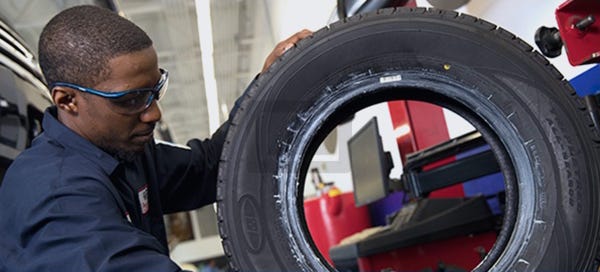Experience Precision with GMC Tire Service at Morris Tires
Experience Precision with GMC Tire Service at Morris Tires
Blog Article
Tire Service: The Impact of Climate Condition
When it comes to making sure optimal efficiency and security when traveling, recognizing the influence of climate condition on tire service is critical. From scorching warm to icy roadways, each weather condition component can dramatically influence tire functionality and general driving experience. By diving right into the impacts of differing weather conditions on tires, vehicle drivers can obtain useful insights that might enhance their automobile's performance and durability. In this conversation, we will certainly check out the elaborate connection in between weather condition problems and tire service, shedding light on the significance of weather-specific tire upkeep practices and considerations.
Heat and Tire Efficiency
When exposed to high temperature levels, tires experience adjustments in performance that can dramatically influence vehicle safety and handling. The warm created from prolonged driving or warm weather conditions creates the tire rubber to soften, leading to reduced tread life and increased wear.

Cold Weather Results
Cold weather problems can have a considerable impact on tire efficiency and security. In cold weather condition, tires may additionally shed air stress extra quickly, which can affect managing and gas performance.
To mitigate the effects of winter on tires, it is vital to routinely inspect tire stress and inflate them to the manufacturer's recommended degrees. Making use of winter months or all-season tires designed for winter problems can also boost traction and hold on icy or snowy roads. Proper tire upkeep, consisting of regular inspections for wear and damages, ends up being a lot more important during colder months to ensure optimal performance and safety.
Rainy Conditions Influence
Tires with damaged footsteps are extra prone to hydroplaning, where a layer of water develops up between the tire and the roadway surface area, leading to loss of grip. To fight this, chauffeurs need to regularly check their tires for adequate walk deepness and consider spending in tires specifically made for wet conditions.
Moreover, rainy climate can likewise decrease visibility, making it testing for vehicle drivers to see the roadway in advance plainly (GMC Tire Service). In such conditions, it is vital to adjust driving rates as necessary and keep a safe following distance to permit unexpected quits. Appropriately filled with air tires can likewise aid in preserving control on wet roadways by giving better handling and grasp
Snow and Tire Safety And Security
Snow-covered roadways present one-of-a-kind challenges for chauffeurs, emphasizing the importance of correct tire option and upkeep. When driving in snowy problems, having the ideal tires can make a considerable difference in security and performance. Winter tires are designed with unique rubber compounds and step patterns to offer far better traction on snow and ice compared to all-season tires. The much deeper footsteps and sipes of winter season tires assist grip the road better, decreasing the danger of sliding and slipping.

It is crucial to adhere to producer instructions when using and setting up tire chains to stop damage to the tires and vehicle. By selecting the ideal tires, keeping correct rising cost of living, and thinking about added traction aids like tire chains, drivers can enhance he has a good point their security when browsing snow-covered roadways.
Weather-Related Tire Upkeep
When confronted with various climate condition, proper tire maintenance comes to be an essential aspect of automobile safety and security and performance. Weather-related tire maintenance encompasses a series of techniques focused on guaranteeing ideal tire feature and durability in various weather circumstances. One crucial element of weather-related tire upkeep is tire pressure law. Changing temperatures can create tire pressure to differ, influencing grip and fuel efficiency. On a regular basis examining and changing tire stress according to producer referrals is important for secure driving in transforming weather condition problems. In addition, tire walk deepness plays a substantial role in managing different climate aspects. Tires with appropriate tread deepness give far better grasp on wet or icy roadways, minimizing the risk of skidding or hydroplaning. Examining tire step consistently and replacing tires when walk wear gets to a specific depth is crucial for preserving traction and stability in unfavorable weather condition. By prioritizing weather-related tire upkeep, vehicle drivers can improve safety, improve automobile efficiency, and extend the lifespan of their tires.
Verdict
Finally, climate condition have a considerable effect on tire efficiency and security. From warm influencing tire stress and use to winter reducing grip, it is vital to take into consideration the climate when preserving and using tires. Wet problems can decrease hold and result in hydroplaning, while snow can enhance the danger of accidents if tires are not correctly geared up. Weather-related tire maintenance is crucial in ensuring optimal efficiency and safety and security when traveling.
In this conversation, we will certainly Discover More Here discover the elaborate partnership in between weather problems and tire solution, dropping light on the value of weather-specific tire upkeep practices and considerations.

Report this page